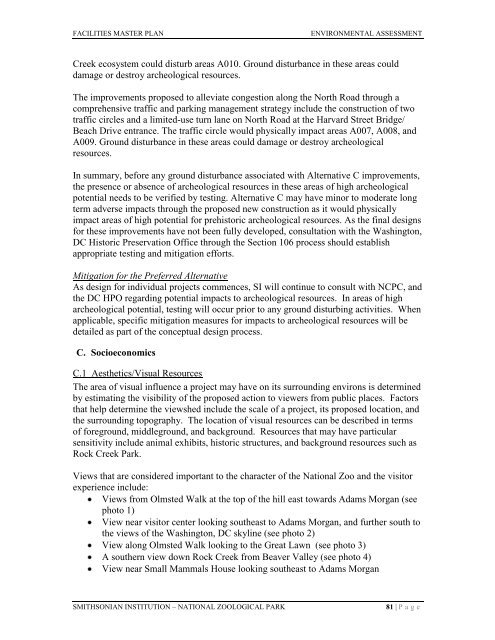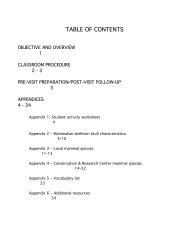facilities renewal master plan - National Zoo - Smithsonian Institution
facilities renewal master plan - National Zoo - Smithsonian Institution
facilities renewal master plan - National Zoo - Smithsonian Institution
You also want an ePaper? Increase the reach of your titles
YUMPU automatically turns print PDFs into web optimized ePapers that Google loves.
FACILITIES MASTER PLAN ENVIRONMENTAL ASSESSMENT<br />
Creek ecosystem could disturb areas A010. Ground disturbance in these areas could<br />
damage or destroy archeological resources.<br />
The improvements proposed to alleviate congestion along the North Road through a<br />
comprehensive traffic and parking management strategy include the construction of two<br />
traffic circles and a limited-use turn lane on North Road at the Harvard Street Bridge/<br />
Beach Drive entrance. The traffic circle would physically impact areas A007, A008, and<br />
A009. Ground disturbance in these areas could damage or destroy archeological<br />
resources.<br />
In summary, before any ground disturbance associated with Alternative C improvements,<br />
the presence or absence of archeological resources in these areas of high archeological<br />
potential needs to be verified by testing. Alternative C may have minor to moderate long<br />
term adverse impacts through the proposed new construction as it would physically<br />
impact areas of high potential for prehistoric archeological resources. As the final designs<br />
for these improvements have not been fully developed, consultation with the Washington,<br />
DC Historic Preservation Office through the Section 106 process should establish<br />
appropriate testing and mitigation efforts.<br />
Mitigation for the Preferred Alternative<br />
As design for individual projects commences, SI will continue to consult with NCPC, and<br />
the DC HPO regarding potential impacts to archeological resources. In areas of high<br />
archeological potential, testing will occur prior to any ground disturbing activities. When<br />
applicable, specific mitigation measures for impacts to archeological resources will be<br />
detailed as part of the conceptual design process.<br />
C. Socioeconomics<br />
C.1 Aesthetics/Visual Resources<br />
The area of visual influence a project may have on its surrounding environs is determined<br />
by estimating the visibility of the proposed action to viewers from public places. Factors<br />
that help determine the viewshed include the scale of a project, its proposed location, and<br />
the surrounding topography. The location of visual resources can be described in terms<br />
of foreground, middleground, and background. Resources that may have particular<br />
sensitivity include animal exhibits, historic structures, and background resources such as<br />
Rock Creek Park.<br />
Views that are considered important to the character of the <strong>National</strong> <strong>Zoo</strong> and the visitor<br />
experience include:<br />
Views from Olmsted Walk at the top of the hill east towards Adams Morgan (see<br />
photo 1)<br />
View near visitor center looking southeast to Adams Morgan, and further south to<br />
the views of the Washington, DC skyline (see photo 2)<br />
View along Olmsted Walk looking to the Great Lawn (see photo 3)<br />
A southern view down Rock Creek from Beaver Valley (see photo 4)<br />
View near Small Mammals House looking southeast to Adams Morgan<br />
SMITHSONIAN INSTITUTION – NATIONAL ZOOLOGICAL PARK 81 | P a g e

















